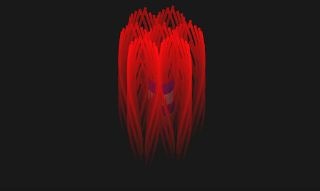May 4 2018
Whether in a heavy elephant or an accelerating cheetah, the performance of bone is equally superior due to its high strength and toughness.
 Interweaving mineral and protein form continuous networks to provide the strength essential for functional bones. (Image credit: Dr Roland Kröger)
Interweaving mineral and protein form continuous networks to provide the strength essential for functional bones. (Image credit: Dr Roland Kröger)
The superior properties of bone are due to its hierarchical organization, in which small elements form larger structures.
However, complete knowledge of the nanoscale organization and the link between the principal components of bone - protein, and mineral - is still lacking.
Imaging
Research groups from the University of York and Imperial College, London used state-of-the-art 3D nanoscale imaging of the mineral in the human bone to demonstrate that the bone’s mineral crystals have a hierarchical structure combined into the larger scale composition of the skeleton.
Scientists blended several advanced electron microscopy-based methods and discovered that the main building blocks of mineral at the nanometer scale are curved needle-shaped nanocrystals forming larger twisted platelets that look like propeller blades. Throughout the protein phase of bone, the blades continuously merge and split. Continuous networks are formed by the interweaving protein and mineral to provide the strength needed for functional bones.
According to Associate Professor Roland Kröger, lead author of the study, from the University of York’s Department of Physics, “Bone is an intriguing composite of essentially two materials, the flexible protein collagen and the hard mineral called apatite.”
“There is a lot of discussion about the way these two stiff and flexible phases uniquely combine to provide toughness and strength to bone.”
“The combination of the two materials in a hierarchical manner provides bone with mechanical properties that are superior to those of its individual components alone and we find that there are 12 levels of hierarchy in bone.”
Fractals
If we compare this arrangement, for example, to an individual living in a room of a house, this extends to a house in a street, then the street in a neighbourhood, a neighbourhood in a city, a country and on it goes. If you continue to 12 levels you are reaching the size of a galaxy!
Dr. Natalie Reznikov, Co-Author
This work builds on the shoulders of many beautiful previous studies investigating the fundamental properties and structure of bone and helps to unlock an important missing piece of the puzzle.
Professor Molly Stevens, Imperial College, London
Apart from the huge number of nested structures contained in bone, an attribute common to all the structures is a slight curvature, offering the twisted geometry. To mention a few, the mineralized collagen fibrils twist, the protein strands (collagen) are braided, the mineral crystals are curved, and the entire bones themselves have a twist, similar to those seen in the curving shape of a rib, for instance.
Fractals are very common in nature: self-similar patterns can be seen in snowflakes, clouds, tree branches, coastlines, and lightning bolts. This relates to the fact that the structure of bone obeys a fundamental order principle in nature. The authors consider that the fractal-like structure of bone is one of the main reasons for its striking features.
Revealing the remarkable nanostructure of human bone
Revealing the remarkable nanostructure of human bone. (Credit: University of York)